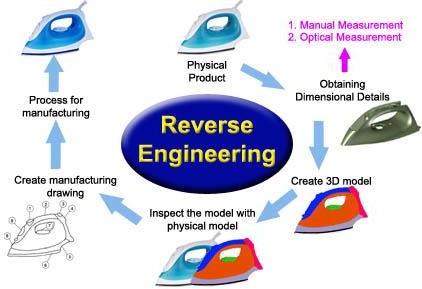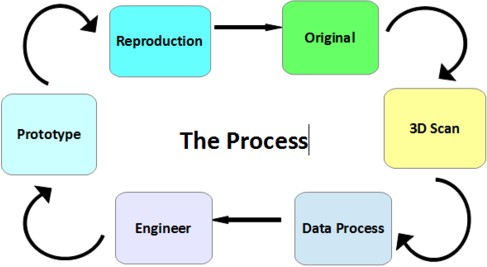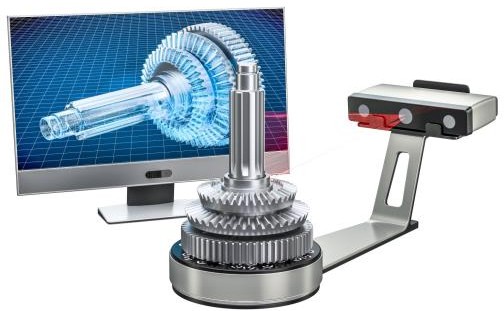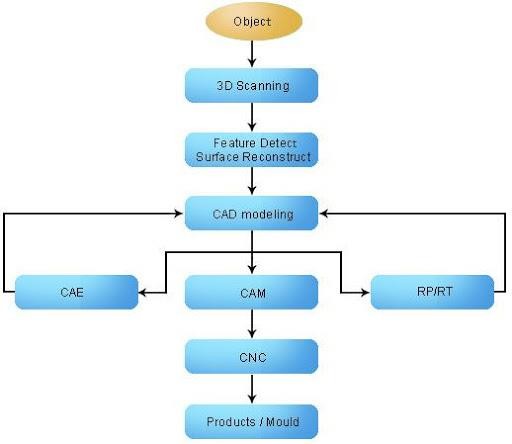Mechanical engineering has been evolving itself with such as lot of new technologies came. This article has the few lines about Reverse Engineering for the purpose of 3D Scanning ,CAD-CAM and 3D Printing.
What Is Reverse Engineering and How Does It Work?
Table of Contents:
▪ What is Reverse Engineering?
▪ The Reverse Engineering Process
▪ What is the Purpose of Reverse Engineering?
Over the past 120 years, manufacturers around the world have produced millions of machine products and parts. Due to continual advances in technology, few of these products have remained relevant for more than several years after their initial release. However, numerous old parts used in machines have stood the test of time. When the part malfunctions or breaks down completely, you replace the component, not the whole device. A process known as reverse engineering makes replacing these parts possible.
What is the purpose of reverse engineering? In any given factory or office building, you’re likely to see manufacturing or computing systems comprised of sophisticated equipment. Typically, the parts in question will range in age from new to more than 20 years old. For these systems to remain intact, various components must be reverse engineered and recreated.
What is Reverse Engineering?
- Reverse engineering, sometimes called back engineering, is a process in which software, machines, aircraft, architectural structures and other products are deconstructed to extract design information from them. Often, reverse engineering involves deconstructing individual components of larger products. The reverse engineering process enables you to determine how a part was designed so that you can recreate it. Companies often use this approach when purchasing a replacement part from an original equipment manufacturer (OEM) is not an option.
 The reverse engineering process is named as such because it involves working backward through the original design process. However, you often have limited knowledge about the engineering methods that went into creating the product. Therefore, the challenge is to gain a working knowledge of the original design by disassembling the product piece-by-piece or layer-by-layer.
The reverse engineering process is named as such because it involves working backward through the original design process. However, you often have limited knowledge about the engineering methods that went into creating the product. Therefore, the challenge is to gain a working knowledge of the original design by disassembling the product piece-by-piece or layer-by-layer.
- Companies often use reverse engineering on old electronic components, such as discontinued printed circuit boards (PCBs) and connecting cards. Frequently, the products in question will come from manufacturers that have since gone out of business. If the manufacturer is still in business, they might no longer offer the The firms often reverse engineer old electronics for the sake of continuity.
- If an old piece of computer equipment had functions that have since been lost amid the subsequent changes in technology, reverse engineering allows manufacturers to rediscover these formulas and bring them up to date. Reverse engineering also enables you to develop components that bridge the new and the old, allowing users of older equipment to connect their devices to modern computing equipment.
- In some cases, the only way to obtain the design of an original product is through reverse engineering. With some older products that have not been manufactured for 20 years or more, the original 2D drawings are no longer available. Often, there will be no way to contact the original manufacturer, as the company may no longer be in business.
- Companies sometimes use reverse engineering to regain design data on their own long- discontinued products. For example, a small company that has been in businesses for more than 40 years may have manufactured numerous products before the days of computer-aided design and digital file storage. Consequently, these older products may be based on long-lost paper blueprints. Through reverse engineering, companies can regain their lost designs and create archives of their product legacy.

- Even if the company still has their paper blueprints, they may want to create a digital version of them to make the plans easier to access and use. The business could use certain reverse engineering techniques to create this digital design file.
- Among auto restoration specialists, reverse engineering is sometimes employed to recreate the designs of engines and auto body parts for older vehicles. Using reverse engineering to rebuild engines or recreate hard-to-find parts can make cars from the 1920s through the 1950s drivable again. Thanks to reverse engineering, you could bring a classic vehicle back to life and make it fully functional without changing the design of the car’s systems.
- Reverse engineering requires a series of steps to gather precise information on a product’s dimensions. Once collected, you can store the data in digital archives. Often, engineers will enhance the design with new developments and innovations. Sometimes, they will replicate the original model exactly.
The Reverse Engineering Process:
- To reverse engineer a physical product, an organization will typically acquire an example of the product in question and take it apart to examine its internal mechanisms. This way, engineers can unveil information about the original design and construction of the product.
- When reverse engineering a mechanical product, you start by analyzing the dimensions and attributes of the product in question, be it an aircraft, ship, vehicle, computer or piece of industrial machinery. During this analysis, you make measurements of the widths, lengths and heights of key components in the product, as these dimensions often relate to the product’s performance capacity.
 Today, some engineers use 3D scanning technologies to make these kinds of measurements. With three-dimensional scanners, engineers can gain accurate readings of the product’s specs and have this information automatically logged in their databases. 3D scanning technologies include coordinate measuring machines (CMM), industrial computed tomography (CT) scanners, laser scanners and structured light digitizers.
Today, some engineers use 3D scanning technologies to make these kinds of measurements. With three-dimensional scanners, engineers can gain accurate readings of the product’s specs and have this information automatically logged in their databases. 3D scanning technologies include coordinate measuring machines (CMM), industrial computed tomography (CT) scanners, laser scanners and structured light digitizers.
- After all the pertinent information has been gathered and recorded, you can use this data to create computer-aided design (CAD) drawings for subsequent analysis and development. CAD drawings are digital two-dimensional and three-dimensional representations of the products, which you can use to analyze the product’s design. These digital models help to unveil design intent and inform the creation of a reverse-engineered component.
- Reverse engineering is often necessary in the development of computer parts due to the obsolescence of parts from prior years. For example, you might have one product with a unique innovation from two year’s earlier, but the manufacturer has since gone out of business. To link that innovation to a newer product for convenience and continuity’s sake, the engineering team will need to examine the obsolete product for its technological makeup.
 In order to reverse engineer a PCB, technicians start by examining and identifying the various components of the board. Each board will typically have resistors, capacitors, LEDs, a transistor, an inductor and various other features. The task here is to determine how the layout of these features gives the PCB its unique capabilities.
In order to reverse engineer a PCB, technicians start by examining and identifying the various components of the board. Each board will typically have resistors, capacitors, LEDs, a transistor, an inductor and various other features. The task here is to determine how the layout of these features gives the PCB its unique capabilities.
- Before disassembly, the reverse-engineering team will photograph the board up close from the front and back to create a record of the board’s Once the notes and images are collected, the engineers begin the process of deconstructing the board.
- During disassembly, the team removes each part from the board, one after The parts must be set aside for safekeeping and organized in the order they were removed. This way, the board can be reassembled later on, if necessary. In cases where the objective is to replicate the design in question, engineers might test their ability to replicate the product by disassembling and reassembling an existing copy several times over.
- As the team sets aside removed components, they take value measurements of key parts, including the capacitors and This step helps the team gain a greater understanding of the engineering that went into the original design. It also provides insight into how the board’s components work together to enable the PCB to function correctly.
- With the various components removed from the old board, the team then draws up a list of the materials and the order in which they were placed on the PCB. The team will also scan the board’s trace pattern so that they can recreate it later.
- The reverse-engineering team may then use the pieces at hand and the information collected to assemble a new board. First, they lay out a new board and then install the components in the same order used for the original PCB. Once assembled, the new board is run through a series of tests to determine its functionality. The team will digitally document the results of these tests for future study.
What is the Purpose of Reverse Engineering?
- Reverse engineering provides manufacturers with information about the design of a product or component. When done successfully, reverse engineering gives you a virtual copy of the blueprint that went into the original design.
- Reverse engineering is perhaps the most accurate way to recreate the designs for items that went out of production decades In cases where the original blueprints are long since lost or destroyed, reverse engineering is perhaps the only way to bring such products back to life. If you can obtain a working model of an old product, you can typically trace the steps of its design and use those insights to construct a new model, repair a part or improve future products.

- Below are some of the most common uses of reverse
1. Legacy Parts Replacement:
- One of the most common reverse engineering applications is legacy parts replacement, which involves examining and reproducing select parts of larger machines to keep them in operation.
- For example, a factory might have a large engine compartment that keeps the entire conveyor system running through each day’s work shift. Every once in a while, one of the machine parts will wear out and need to be replaced. If the machine is old, certain parts might no longer be in production, either because the OEM no longer makes the part of is out of business.
- While the factory could make a huge investment in a new conveyor system, the preferable option is to retain the same equipment and replace the faulty With reverse engineering, you can use a 3D scanner to digitally replicate the design of the defective part. From there, a new copy of the component can be created and installed into the machine.
- Depending on the size and complexity of the component in question, the initial cost to have it reverse engineered could exceed the price of a newer or different However, once you have created a digital copy of the original design and successfully replicated the part, you can use that information to recreate the component again and again. Reverse engineering allows you to reproduce parts that work in your preferred mechanical setups, regardless of whether the original manufacturers are still in business.
2. Parts Service or Repair:
- If a legacy part or a component the OEM no longer supports needs repair or service, it’s useful to have an understanding of how the product works. This knowledge can help to complete the repair accurately and If there aren’t any design documents available, a company may use reverse engineering to create them. You can then use this information to inform how you repair or service the part. The data you gain from reverse engineering can help you determine which components you need to replace to fix a given problem. It can also inform your repair process by helping you better understand how best to access, remove and replace a certain part.
3. Failure Analysis:
- Reverse engineering techniques can play a valuable role in failure analysis. If a machine fails, you may need to take it apart or examine design files to determine Once you have this information, you know how to fix or improve the product so that it functions properly again.
- Examining a product using reverse engineering can reveal damaged parts of faulty designs. Looking at digital design files created through reverse engineering can also reveal flaws and help inform how you plan to repair a piece of
4. Parts Improvement:
- Reverse engineering is also used for parts improvement. You might need to alter a component after conducting a failure analysis, or a particular might just be due for an upgrade. If no replacement or alternative part is available on the market, you could have the part reverse engineered to create a copy of the original design. From there, you could modify the design for improved performance.
- If a machine requires stronger joints or weld reinforcements, the faulty parts will be examined for their measurements and redesigned with increased thickness or stronger metals. Through reverse engineering, you can determine which dimensions must be maintained and which aspects you can change. If you could combine two or more parts into a single, more functional component, reverse engineering could bring that fact to light.
5. Diagnostics and Problem-Solving:
- Reverse engineering can also be used for diagnostics and problem-solving in a sequence of industrial processes. In a factory setting, the flow of operations can sometimes slow due to a faulty or underperforming function. When a manufacturing system consists of numerous machines and components, it can be difficult to pinpoint the source of the problem. Through reverse engineering, you can determine how everything works as one and use that knowledge to identify where things can and do go wrong.
